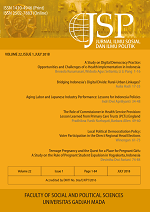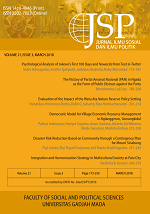A Tsunami-Related Life History of Survivors in Banda Aceh, Indonesia and Sendai, Japan
Agus Suwignyo(1*)
(1) History Department, Faculty of Cultural Sciences and the Center for Southeast Asian Social Studies, Universitas Gadjah Mada
(*) Corresponding Author
Abstract
In tsunami risk-reduction programs the survivors’ life history provides first-hand information about how they responded during and after a catastrophe. However, knowledge of tsunami-related experiences is not always systematically managed and institutionally communicated across generations. Some risk reduction programs lack of informed knowledge of tsunami-related experiences and consequently tend to be insensitive towards survivors’ life history. The aim of this paper is to examine how tsunami survivors constructed their tsunami-related knowledge and collective memories, taking the cases of Banda Aceh, Indonesia after the 2004 tsunami and Sendai, Japan after the 2011 tsunami. This paper, in particular, seeks to explore how the survivors’ experience helped to institutionalize their tsunami-related knowledge in a transferrable risk-reduction consciousness. Using first-hand interviews as well as interview recordings which were accessible online, this paper argues that in both cases of tsunami survivor cohorts, knowledge of tsunami-related experience was constructed through survival strategies and recovery processes in the aftermath of the events. Knowledge of survival strategies was constructed over time; and the longer period from the time of event, the more tacit the knowledge was. The process of knowledge construction was systematic in the Sendai case but was vernacular in the Banda Aceh case. However, in both cases the need for more engaged institutional communication between the government agencies and the people was evident.
Keywords
Full Text:
PDFReferences
Arif, A. (2012, November 21). Mendidik sadar becana lewat komik. Kompas, p. 14
Chandler, S. (2005). Oral history across generations: Age, generational identity and oral testimony. Oral History 33(2), 48–56.
Dudley, W, Goff, J., Chagué-Goff, C., & Johnston, J. (2009). Capturing the next generation of cultural memories: The process of video interviewing tsunami survivors. Science of Tsunami Hazards 28(3), 159–170.
Ehrentraut, S. (2010). Dividing Aceh? Minorities, partition movements and state-reform in Aceh Province. SSRN. Retrieved from https://ssrn.com/abstract=1716587.
Fackler, M. (2011, April 20). Tsunami warning, written in stones. Retrieved October 4, 2019, from https://www.nytimes.com/2011/04/21/world/asia/21stones.html.
FrdTBO, Chaîne de. (2011, October 8). Japan Tsunami in Sendai [Video file]. Retrieved February 1, 2015, from https://www.youtube.com/watch?v=qOlL2kbKGFQ.
Fitzpatrick, D. (2008). Women’s right to land and housing in tsunami-affected Aceh, Indonesia. Retrieved from http://www.ari.nus.edu.sg/docs/downloads/aceh-wp/acehwps08_003.pdf.
Friedman, J. (2014, January 10). Japan’s tsunami 2011 [Video file]. Retrieved February 1, 2015, from https://www.youtube.com/watch?v=KCfzMG-HBCk.
Gaillard, J.C. &Texier, P. (2010). Religion, natural hazards, and disasters: An introduction. Religion 40, 81 – 84. doi: https://doi.org/10.1016/j.religion.2009.12.001.
Hidayat, R. (2019). Public distrust and environmental citizenship: Primary impetuses of radical protest in Bima District 2011-2012. Jurnal Ilmu Sosial dan Ilmu Politik, 23(3), 187-200. doi: 10.22146/jsp.35981.
Iemura, H., Takahashi, Y., Pradono, M. H., Sukamdo, P. & Kurniawan, R. (2006). Earthquake and tsunami questionnaires in Banda Aceh and surrounding areas. Disaster Prevention and Management, 15(1), 21-30. doi: https://doi.org/10.1108/09653560610654211.
Kawato, Y., Pekkanen, R., & Tsujinaka, Y. (2012). Civil society and the triple disasters: Revealed strengths and weaknesses. In J. Kingston (Ed.), Natural disaster and nuclear crisis in Japan: Response and recovery after Japan’s 3/11 (pp. 78–93). Oxon: Nissan Institute/Routledge Japanese Studies Series.
Kingston, J. (2012). Introduction. In J. Kingston (Ed.), Natural disaster and nuclear crisis in Japan: Response and recovery after Japan’s 3/11 (pp. 1–11). Oxon: Nissan Institute/Routledge Japanese Studies Series.
Kjaergaard, E. (2015). Child center disaster risk reduction in South Asia: Basic Concepts. Kathmandu: UNICEF Regional Office for South Asia. Retrieved from http://ndmc.gov.mv/assets/Uploads/48413-childcentereddrrsouthasia2015.pdf.
Kohlstedt, K. (2016, August 15). Tsunami stones: Ancient Japanese markers warn builders of high water. Retrieved October 4, 2019, from https://99percentinvisible.org/article/tsunami-stones-ancient-japanese-markers-warn-builders-high-water/
Lestari, P., Paripurno, E.T., & Nugroho, A. R. B. (2018). Disaster risk reduction based on community through contigency plan for Mount Sinabung. Jurnal Ilmu Sosial dan Ilmu Politik, 21(3), 231-245. doi: 10.22146/jsp.30059
McAdoo, B.G., Dengler, L., Prasetya, G., & Titov, V. (2006). Smong: How an oral history saved thousands on Indonesia’s Simeulue Island during the December 2004 and March 2005 tsunamis. Earthquake Spectra, 22(3), 661–669. doi: 10.1193/1.2204966
Merli, C. (2010). Context-bound Islamic theodicies: The tsunami as supernatural retribution vs. natural catastrophe in Southern Thailand. Religion 40, 104-111. doi: 10.1016/j.religion.2009.12.003
Miller, M. A., & Bunnel, T. (2011). Post-disaster urban renewal: Memories of trauma and transformation in an Indonesian city. Asia Research Institute. Retrieved from http://www.ari.nus.edu.sg/wps/wps11_154.pdf.
N.N. (2012, October 12). Pendidikan Bencana Lewat Manga. Kompas, p. 14.
N.N. (2013, March 11), Pelajaran dari Tsunami Jepang, Kompas, p. 10.
Neumayer, E., & Plümper, T. (2007). The gendered nature of natural disasters: the impact of catastrophic events on the gender gap in life expectancy, 1981–2002. Annals of the Association of American Geographers, 97(3), 551–566.
Octastefani, T., & Rum, M. (2019). Millennials’ contribution in disaster risk reduction: Case study of tidal flooding in Semarang. Jurnal Ilmu Sosial dan Ilmu Politik, 23(1), 14-29. doi: 10.22146/jsp.43727
Prez, T. (2011, December 13). Japan’s tsunami caught on camera [Video file]. Retrieved February 1, 2015, from https://www.youtube.com/watch?v=oArd_9uZOnE.
Rahman, A., Sakurai, A., & Munadi, K. (2018). The analysis of the development of the Smong story on the 1907 and the 2004 Indian Ocean tsunamis in strengthening the Simeuleu island community’s resilience. International Journal of Disaster Risk Reduction, 29, 13–23. doi: 10.1016/j.ijdrr.2017.07.015.
Reid, A. (2016). Two hitherto unknown Indonesian tsunami of the seventeenth century: Probabilities and context. Journal of Southeast Asian Studies, 47(1), 88–108. doi: 10.1017/S002246341500048X
Rofi, A., Doocy, S,. & Robinson, C. (2006). Tsunami mortality and displacement in Aceh province, Indonesia. Disasters, 30(3), 240–250. doi: 10.1111/j.0361-3666.2005.00324.x
Samek, J. H., Skole, D. L., & Chomentowski, W. (2004). Assessment of impact of the December 26, 2004 tsunami in Aceh Province Indonesia. Center for Global Change and Earth Observations. Retrieved from http://www.landsat.org/trfic/tsunami2004/Assessment_of_Tsunami04.pdf.
Schlehe, J. (2010). Anthropology of religion: Disasters and the representations of traditions and modernity. Religion, 40, 112–120. doi: 10.1016/j.religion.2009.12.004
Shibata, A. (2012). Importance of the inherited memories of great tsunami disasters in natural disaster reduction. In Proceeding of the International Symposium on Engineering Lessons Learned from the 2011 Great East Japan Eartquake. Tokyo, March 1–4.
Sugimoto, M., Iemura, H., & Shaw, R. (2010). Tsunami height poles and disaster Awareness: memory, education and awareness of disaster on the reconstruction for resilient city in Banda Aceh, Indonesia. Disaster Prevention and Management, 19(5), 527-540. doi: 10.1108/09653561011091869
Tedbudiyansah. (2013, December 24). Ibena. Retrieved from http://tedbudiyansyah.tumblr.com/post/71016145463/ibena-salah-satu-istilah-yang-telah-ada-dalam.
UNDRR [United Nations Office for Disaster Risk Reduction]. (2012, October 22–25). 5AMCDRR: 5th Asian ministerial conference on disaster risk reduction. Retrieved from https://www.unisdr.org/we/inform/events/23540.
Valent, P. (1998). From survival to fulfillment: A framework for the life-trauma dialectic. Philadelphia: Bruner/Mazel. Retrieved from http://www.trauma-pages.com/a/valent98.php, p. 4.
Veras, J. H., Taniguchi, T., Jaller, M., Aros-Vera, F., Ferreira, F., & Thompson, R. G. (2014). The Tohoku disasters: Chief lessons concerning the post disaster humanitarian logistics response and policy implications, Transportation Research Part A: Policy and Practice, 69(Nov), 84-108. doi: 10.1016/j.tra.2014.08.003.
Article Metrics
Refbacks
- There are currently no refbacks.
Copyright (c) 2019 Jurnal Ilmu Sosial dan Ilmu Politik

This work is licensed under a Creative Commons Attribution-NonCommercial-NoDerivatives 4.0 International License.






















